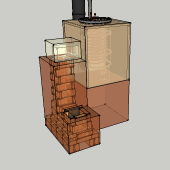Amos Valenti wrote:Natalie: Our thinking was that if a stream of hot air was forced into a body of cold water, the temperature of the water would rise. How much and how fast are the variables. Im not sure about the relationship between the bubbles rising and the heat escaping but I see how one came come to that conclusion. The bubbles, in this case, benefit to our AP system by adding more oxygen into the water.
This is all correct, and perhaps I can add more details and some context to my prior comments.
1.) Heat transfer by the gas to the water is foremost determined by the temperature of the gas and its flow rate. There are some additional factors involving the bubbling that I'll discuss a bit later.
2.) In an open system of the type you have described, the back pressure on the pump moving the hot air has to work against the friction in the pipe and the depth of the water in which the open end sits.
3.) Pipe Friction: The friction in the pipe goes up as the flow rate goes up, and as the diameter of the pipe goes down. So moving air fast down a skinny pipe means that your pump will have to work much harder than pushing air slowly through a fat pipe.
4.) Immersion depth of open end: the deeper it is, the harder your pump must work. However, the deeper it is, the longer that your bubbles have to transfer their heat to the water. So there's a trade-off here. A closed system does not have to pay this penalty, but you won't get oxygenation, and you will need a pump that can handle whatever temperature gas comes BACK from the water, if you can't dump all the heat.
5.) Bubbles: smaller bubbles will transfer their heat more efficiently to the water, because they have a larger surface area/volume ratio. Also, smaller bubbles will take longer to rise for essentially the same reason (more resistance per buoyant force on the bubble). However, it effectively takes additional pump energy in the form of using a smaller pipe, or using a bubbler tip at the end. Again, a trade-off.
Your break-even in terms of input energy is that you need to get more heat energy from the water than you are using to pump the air, less whatever energy you save by not having to run a different oxygenation system.



